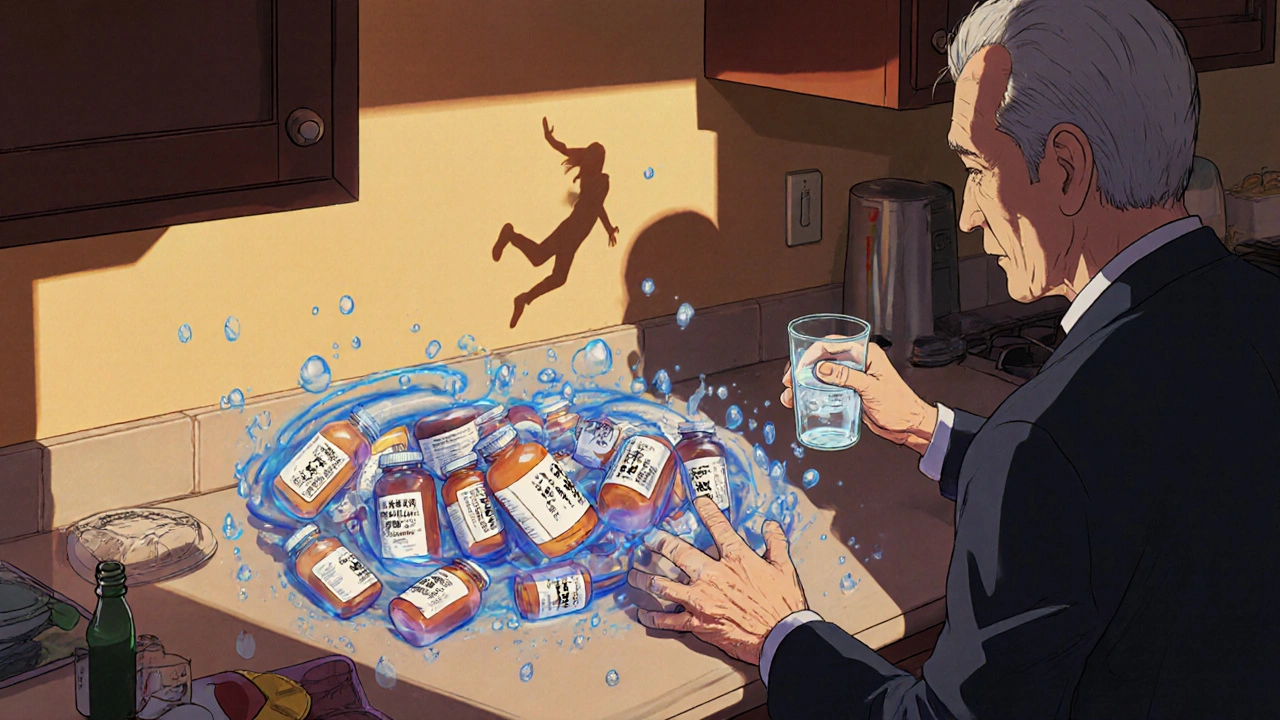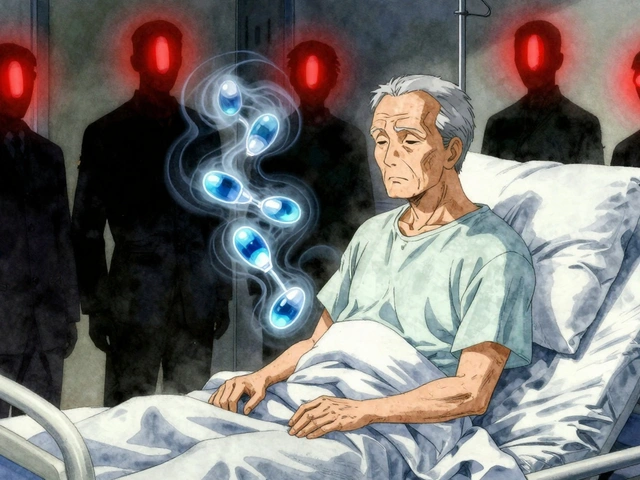
Medication Fall Risk Checker
This tool helps you understand how your medications might increase fall risk. Based on research, many common drugs can affect balance, coordination, and blood pressure. Enter your medications below to see which ones might be a concern.
Every year, nearly one in three adults over 65 falls. Many of these falls aren’t accidents-they’re side effects of medications. It’s not just about being unsteady on your feet. It’s about what’s in your medicine cabinet.
Why Medications Turn Everyday Movements Into Dangerous Moments
Falls aren’t just bruises or scrapes. For older adults, a single fall can mean a broken hip, a hospital stay, or even death. In the U.S. alone, over 36,000 older adults died from falls in 2023. And the biggest driver? Medications. Research shows that 65% to 93% of older adults who fall are taking at least one drug known to increase fall risk. These aren’t rare cases. This is a widespread, preventable problem.The issue isn’t that doctors are careless. It’s that many medications prescribed for common conditions-sleep trouble, anxiety, high blood pressure, chronic pain-have hidden dangers. These drugs slow reaction time, blur vision, lower blood pressure suddenly, or make you feel dizzy when you stand up. And most older adults don’t realize their meds are the cause.
The Top 9 Medication Classes That Raise Fall Risk
Nine drug categories are consistently linked to higher fall rates in older adults. Not all are equally risky, but all deserve attention.- Antidepressants - Especially tricyclics (like amitriptyline) and SSRIs (like sertraline). These are the most strongly tied to falls. They affect balance, coordination, and can cause dizziness. Studies show people on antidepressants have up to a 60% higher fall risk than those not taking them.
- Benzodiazepines - Drugs like diazepam (Valium), lorazepam (Ativan), and alprazolam (Xanax). These are sedatives, often prescribed for anxiety or sleep. Even short-term use increases fall risk by 50%. Long-term use? That’s when the danger spikes. The American Geriatrics Society says these should be avoided in seniors unless absolutely necessary.
- Sedative-Hypnotics - Zolpidem (Ambien), eszopiclone (Lunesta), zaleplon (Sonata). These sleep aids don’t just help you fall asleep-they can leave you groggy the next morning. Some people even sleepwalk or do other activities without remembering. That’s a recipe for a fall in the middle of the night.
- Antipsychotics - Used for dementia-related behaviors or psychosis. First-generation types like haloperidol carry the highest risk. They cause stiffness, slow movement, and dizziness. Even low doses can be dangerous. The National Council on Aging reports a 40% increased fall risk with these drugs.
- Opioids - Painkillers like oxycodone, hydrocodone, and morphine. The higher the dose, the higher the risk. High-potency opioids can increase fall risk by up to 80%. They cause drowsiness, confusion, and low blood pressure-all bad news when you’re trying to get out of bed.
- Diuretics - Water pills like furosemide. These help with heart failure or swelling, but they can make you urinate too often and too fast. That leads to trips to the bathroom at night. And if your blood pressure drops suddenly? You’re at risk of fainting.
- Antihypertensives - Blood pressure meds like amlodipine or lisinopril. These are essential, but if they lower pressure too much, you get orthostatic hypotension-your blood pressure plummets when you stand up. That’s a classic trigger for falls.
- NSAIDs - Ibuprofen, naproxen. These pain relievers can mess with blood pressure control and kidney function. Over time, they may cause fluid shifts and dizziness. Studies show a 25% higher fall risk in users.
- Anticholinergics - Found in bladder meds (oxybutynin), allergy pills (diphenhydramine), and even some sleep aids. They block a brain chemical needed for memory and coordination. Side effects? Dry mouth, blurred vision, confusion. Many seniors don’t realize their daily allergy pill is making them unsteady.
Who’s Most at Risk?
It’s not just about taking one risky drug. It’s about taking multiple. Older adults often see several doctors. One prescribes a sleep aid. Another adds an anxiety pill. A third gives a painkiller. By the time they’re 75, many are on five, six, or even ten medications. That’s called polypharmacy-and it’s a silent killer.People over 80 are at highest risk. So are those with memory issues, Parkinson’s, or a history of previous falls. But the biggest risk factor? Not knowing your meds are dangerous.
A 2023 study found that 63% of older adults taking multiple fall-risk drugs had no idea they were at risk. They didn’t ask. Their doctors didn’t explain. And when they fell, they blamed the floor, not the pill.

What You Can Do: Three Simple Steps
You don’t have to stop all your meds. But you do need to take control.- STOP unnecessary drugs. Ask your doctor: "Is this still needed?" Many prescriptions are kept on auto-pilot for years-even when the original reason is gone. A 78-year-old woman in Auckland started taking diazepam for anxiety after her husband passed away. Five years later, she was falling monthly. Her doctor finally stopped it. Her balance improved in weeks.
- SWITCH to safer options. For insomnia, cognitive behavioral therapy (CBT-I) works better than Ambien-with no side effects. For anxiety, non-benzodiazepine options like buspirone have lower fall risk. For pain, physical therapy or acetaminophen may be safer than NSAIDs or opioids.
- REDUCE doses. Sometimes, half a pill is enough. Lowering the dose of a sedative or antidepressant can cut fall risk without losing benefits. Always taper slowly under medical supervision.
Bring all your meds-prescription, over-the-counter, vitamins, herbal supplements-to your next appointment. Use the "brown bag method." Many people don’t realize their nighttime cough syrup or allergy pill contains diphenhydramine, an anticholinergic. That’s a hidden fall risk.
Who Should Be Involved?
This isn’t just the patient’s job. It’s a team effort.- Pharmacists - They’re medication experts. Studies show pharmacist-led reviews reduce falls by 22%. Ask for a medication review at your pharmacy.
- Geriatricians - These doctors specialize in older adults. They know which drugs are risky and which aren’t. If your primary care doctor doesn’t mention fall risk, ask for a referral.
- Caregivers - If you’re helping an older parent, keep a list of their meds. Note when they started, why, and any changes in balance or confusion. Speak up.
What’s Changing in 2025?
Things are shifting. Medicare now penalizes doctors who overprescribe high-risk meds to seniors. Pharmacies are starting to flag dangerous combinations before the prescription is filled. AI tools can now scan a patient’s entire medication list and flag fall risks with 89% accuracy.And the National Institute on Aging has just funded $15 million to study how to safely stop these drugs-without causing withdrawal or worsening symptoms. This isn’t just theory anymore. It’s becoming standard care.

Real Stories, Real Risks
On Reddit, a caregiver wrote: "My mom fell three times after starting Ambien. The third time, she broke her hip. No one told us the sleep aid could make her dizzy all day."A 72-year-old man on GoodRx shared: "I took Xanax for six months. I didn’t realize I was so unsteady until I had to install grab bars in my bathroom. My doctor said it was fine. I wish I’d asked more questions."
These aren’t outliers. They’re examples of a system that’s still too focused on treating symptoms-not preventing harm.
Don’t Wait for a Fall
Falls don’t come out of nowhere. They’re the result of slow, silent changes-drowsiness after lunch, wobbling getting out of bed, forgetting where the stairs are. If you or someone you love is over 65 and on more than three medications, it’s time to have a conversation.Ask: "Could any of these be making me unsteady?"
Ask: "Is there a safer way to manage this?"
Ask: "Can we try going off one of these?"
Medications save lives. But they can also take them away-if we don’t pay attention. The goal isn’t to stop all drugs. It’s to take only what’s truly needed, at the lowest dose possible. That’s how you protect independence, mobility, and life itself.
What medications are most likely to cause falls in seniors?
Antidepressants, benzodiazepines, sedative-hypnotics (like Ambien), antipsychotics, and opioids carry the highest risk. Antidepressants show the strongest link to falls, followed closely by benzodiazepines. Even common over-the-counter antihistamines like diphenhydramine can increase fall risk due to drowsiness and confusion.
Can stopping a medication really reduce fall risk?
Yes. Studies show that carefully reducing or stopping high-risk medications like benzodiazepines or sedative-hypnotics can improve balance and reduce falls within weeks. One study found that seniors who stopped taking these drugs had a 40% lower fall rate over six months. Always taper under medical supervision to avoid withdrawal symptoms.
Are over-the-counter drugs risky too?
Absolutely. Many OTC sleep aids, allergy pills, and cold medicines contain anticholinergics like diphenhydramine or doxylamine. These cause drowsiness, blurred vision, and confusion-all major fall triggers. A 2022 CDC survey found that 65% of older adults didn’t realize their allergy meds could increase fall risk.
How often should seniors have their medications reviewed?
At least once a year, and more often if they’ve had a fall or started a new drug. The CDC’s STEADI program recommends annual medication reviews for everyone over 65. If someone is taking five or more medications, a review every six months is ideal. Bring all pills-even vitamins and supplements-to the appointment.
Is there a safe alternative to sleeping pills for seniors?
Yes. Cognitive Behavioral Therapy for Insomnia (CBT-I) is the first-line recommendation from the American Academy of Sleep Medicine. It’s as effective as sleeping pills, with no side effects or fall risk. Many community health centers now offer CBT-I programs for seniors. It takes a few weeks, but the results last longer than any pill.
Can pharmacists help with fall risk medication reviews?
Yes, and they should. Pharmacists are trained to spot dangerous drug combinations and high-risk medications. A 2023 study showed pharmacist-led reviews reduced fall risk by 22% in older adults. Ask your pharmacy if they offer a free medication review. Many do, especially under Medicare Part D.
What should I do if I think a medication is making me unsteady?
Don’t stop taking it on your own. Write down when you feel dizzy, how often it happens, and what you were doing. Bring this log to your doctor. Say: "I think this medication might be making me unsteady. Can we review it?" Most doctors will agree to a gradual taper or switch. Your safety matters more than sticking to a prescription.
What Comes Next?
If you’re concerned about fall risk, start with a simple step: make a list of every medication, supplement, and OTC pill you take. Include dosages and why you take them. Then, schedule a medication review with your doctor or pharmacist. Bring the list. Ask the hard questions. You’re not being difficult-you’re being smart.Falls don’t have to be inevitable. With awareness, careful review, and the right choices, many can be prevented. The goal isn’t to live without meds. It’s to live without fear-of falling, of losing independence, of the next step being your last.





Eli Grinvald
October 31, 2025 AT 00:07This hit home. My grandma took Ambien for years and never connected her midnight tumbles to the pill. She finally stopped it after her hip fracture-and now she’s dancing in the kitchen again. 🙌❤️
Carly Smith
November 1, 2025 AT 15:12So let me get this straight-you want old people to stop taking meds so they don’t fall… but not stop eating sugar or walking into traffic? Sounds like blaming the pill instead of the person. 🤷♀️
Michael Ferguson
November 3, 2025 AT 13:48Let’s be real-the real issue isn’t the meds, it’s that society has turned aging into a medical problem instead of a natural process. We’ve medicated the human experience into oblivion. Seniors aren’t fragile because of benzodiazepines-they’re fragile because we’ve abandoned them to a system that treats them like broken machines. You don’t fix a person by adjusting dosages. You fix a person by giving them purpose, community, and dignity. But that’s too expensive, right? So we give them Xanax and call it a day. Pathetic.
Angie Creed
November 3, 2025 AT 22:41They say ‘ask your doctor’ like doctors are saints with crystal balls. My uncle’s PCP prescribed him five fall-risk meds in one visit and didn’t blink. The system is broken. We’re not asking-we’re screaming into a void. And now people are dying because we’d rather avoid the uncomfortable conversation than face the truth: medicine is big business, and seniors are the cash cow.
Alexis Hernandez
November 4, 2025 AT 05:28Man, I never thought about OTC stuff being dangerous. My mom takes Benadryl every night for ‘a little help’-turns out it’s basically a chemical tripwire. I’m grabbing her meds tonight and dragging her to the pharmacist. No more ‘it’s just an allergy pill’ nonsense. We gotta be the ones to speak up. Even if it’s awkward.
Brenda Flores
November 4, 2025 AT 14:37As a geriatric nurse with over 25 years of clinical experience, I can confirm that polypharmacy remains the most under-addressed public health crisis among the elderly. The data presented here is not only accurate but conservative. In my practice, I have witnessed multiple cases where discontinuation of anticholinergic agents and sedative-hypnotics resulted in statistically significant improvements in gait stability, cognitive clarity, and reduction in emergency department visits. It is imperative that healthcare providers implement structured medication reconciliation protocols, and that patients and caregivers are educated using plain-language materials. The brown bag method, though simple, remains one of the most effective interventions available. This is not alarmism-it is evidence-based practice.
Kurt Stallings
November 6, 2025 AT 03:45So what’s next? Ban all pills? Make seniors walk barefoot in the snow to ‘build resilience’? This is just another moral panic dressed as public health. People age. They hurt. They sleep poorly. You can’t fix biology with a checklist. The real danger is fear-fear of pills, fear of doctors, fear of aging. Let people live. Let them take their meds. Let them fall if they must. Death isn’t the enemy-control is.
brajagopal debbarma
November 6, 2025 AT 13:39Wow. So the answer is just… stop taking meds? Cool. Next you’ll tell me to stop breathing. I’m 70. I take 8 pills. I don’t fall. I’m fine. You’re the one who’s unsteady.